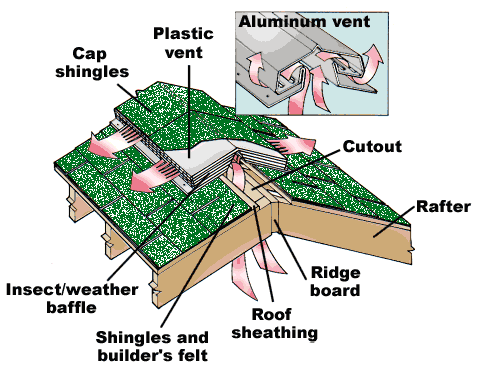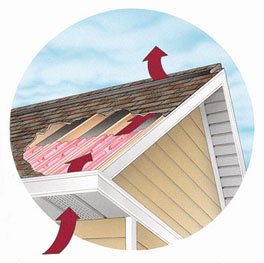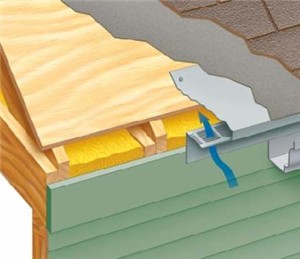Most homeowners do not understand the full meaning and benefits of proper attic ventilation. There’s also a lack
of understanding in how to properly size and position roof vents for an adequate air flow under the roof cavity.
Proper ventilation is absolutely necessary and vital, not only to the health and well being of every home, but also to
every home’s occupant. Anyone who has been in an attic knows that attics get very hot! If the heat in the attic is allowed
to sit there and not ventilate, it will conduct heat into the house, or, at the very least, prevent the heat in the house
and attic cavity from escaping. Without adequate ventilation, your home will encounter problems such as rapid shingle deterioration
(from melting), mold build-up throughout the attic, wood rot and delaminating sheathing, mildew, peeling exterior paint, rusty
nails, energy losses, and many other problems that are often the direct result of inadequate attic ventilation. Wood boring
insects such as Termites and Carpenter Ants are attracted to moisture buildup that is often caused by any inadequate ventilation.
Ironically, improving ventilation conditions can often be accomplished with low to moderate cost expenditures. Once my
clients understand the problems associated with poor ventilation, there is usually a willingness to make these improvements
as soon as they move into their new home. When there is significant damage from poor ventilation such as curling of the roofing
shingles and delaminated roof sheathing with substantial mold or mildew buildup, improving the ventilation becomes secondary
to repairing the damage first.
The most economical answer to this problem is to ventilate the attic. Moving air through the attic will absolutely reduce
the temperature in this cavity. Most homes have passive attic ventilation in the form of a ridge vent at the peak of the roof,
soffit vents in the eaves and gable vents at the top outside gable ends of the home, or some combination of these vents. Turbine
and or roof vents (passive vents that penetrate the roof) are often used as a simple fix for older roofs with inadequate ventilation.
The problem with passive vents is that they require some driving force - wind or temperature differential (hot air rising)
- to move the hot air within the attic. Usually the hottest days of the year are the stillest, with little or no wind. Temperature
differential doesn’t have much energy, so it is slow. Just when you need venting the most, the vents work least effectively.
There is also the installation problem. If your roof cavity was designed without sufficient attic ventilation, adding additional
passive vents may be impractical.
There are two types of air vents that I will always highly recommend: 1.) inlet air vents, also known as Soffit vents and
2.) outlet air vents, also known as Ridge vents. Having only one or the other type of vent is the equivalent of having neither
vent at all. Therefore, to obtain proper attic/roof ventilation, both types of vents must be present, and in equal amounts
of net free air flow.
Another very important detail to these particular vents is to make sure there are fire-proof Styrofoam baffles properly
installed between the insulation and the roof sheathing. These baffles will help maintain the air flow by preventing the insulation
from blocking this vent area. See “STYROFOAM BAFFLE“.
1.) SOFFIT VENT (Allows outside air to enter the attic/roof cavity)

2.) RIDGE VENT (allows air to properly exit attic/roof cavity)

PROPER INSTALLATION OF THESE VENTS AND BAFFLES WILL RESULT IN PERFECT AIR FLOW THROUGHOUT THE ATTIC/ROOF CAVITY.

If your house does not have the soffits or overhangs and your roof stops at the outside wall, you can vent the lower edge
of your roof with a “starter” vent also known as a “drip-edge vent”. This will perform just as well
as a soffit vent, but remember to install the baffles as shown above
DRIP-EDGE VENT




